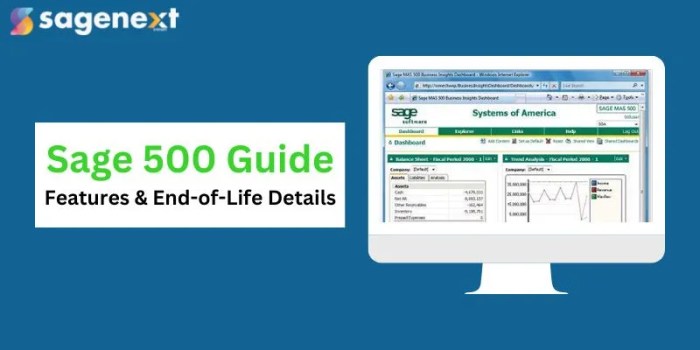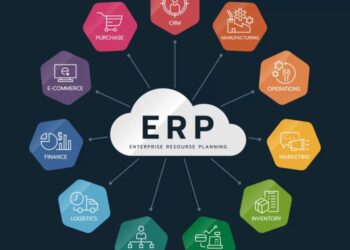Sage 500 lays the foundation for this insightful exploration, offering a detailed narrative that is both informative and engaging. From its rich history to its key features and target market, this topic delves deep into the world of Sage 500 with clarity and originality.
As we delve further, we will uncover the intricacies of Sage 500, shedding light on its implementation, customization options, integration capabilities, and the myriad benefits it offers to businesses.
Overview of Sage 500
Sage 500, formerly known as Sage ERP MAS 500, is a robust enterprise resource planning (ERP) software solution designed to streamline business operations and improve efficiency. It has a rich history of helping medium to large-sized organizations manage their finances, distribution, manufacturing, and other key processes effectively.
Key Features and Functionalities
Sage 500 offers a wide range of features and functionalities to meet the diverse needs of businesses. Some key features include:
- Advanced financial management tools for accurate budgeting and forecasting.
- Inventory management to optimize stock levels and reduce excess inventory costs.
- Purchasing and procurement functionality to streamline the procurement process and improve supplier relationships.
- Sales order processing and customer relationship management tools to enhance sales efficiency and customer satisfaction.
Target Market
Sage 500 is specifically designed for medium to large-sized enterprises across various industries. It caters to businesses looking for a comprehensive ERP solution that can handle complex operations and scale with their growth. With its robust features and scalability, Sage 500 is an ideal choice for organizations seeking to improve operational efficiency and drive business growth.
Implementation of Sage 500

When it comes to implementing Sage 500 in a business, there are several important steps that need to be followed to ensure a smooth transition and successful integration of the software.
Steps Involved in Implementing Sage 500
- Assessment and Planning: The first step involves assessing the business requirements and planning out the implementation process.
- Installation and Configuration: The software is installed on the systems and configured according to the specific needs of the business.
- Data Migration: Existing data is migrated to the new system, ensuring a seamless transfer of information.
- Training: Employees are trained on how to use the software effectively to maximize its potential.
- Testing and Integration: The system is tested to ensure it functions properly and is integrated with other systems within the organization.
- Go-Live: Once everything is in place, the system is launched for regular use across the business.
Training and Support Provided During Implementation
- Training Sessions: Sage 500 provides training sessions for employees to learn how to use the software efficiently.
- Support Services: The software comes with ongoing support services to assist businesses with any issues or questions that may arise during the implementation process.
- Consultation: Businesses can also opt for consultation services to receive personalized guidance on implementing Sage 500 effectively.
Comparison with Other Software Implementation Processes
- Sage 500 vs. QuickBooks: While QuickBooks is known for its user-friendly interface, Sage 500 offers more robust features and customization options, making its implementation process more complex but ultimately more tailored to the specific needs of a business.
- Sage 500 vs. SAP: SAP is a more extensive and expensive software solution compared to Sage 500, requiring a longer implementation process and more extensive training for employees. However, SAP offers more advanced functionalities for large enterprises.
Customization and Integration
Customization and integration are essential aspects of maximizing the functionality of Sage 500. Let's explore the options available and how Sage 500 can be seamlessly integrated with other software or systems.
Customization Options in Sage 500
Sage 500 offers a range of customization options to tailor the system to meet specific business needs. Some of the key customization features include:
- Customized Reports: Users can create custom reports to extract and analyze data according to their unique requirements.
- Personalized Dashboards: Customizable dashboards allow users to have quick access to relevant information and key performance indicators.
- Workflow Automation: Businesses can automate workflows to streamline processes and improve efficiency.
Integration with Other Software or Systems
Sage 500 can be seamlessly integrated with other software or systems to enhance functionality and data sharing. Some common integration scenarios include:
- Integration with CRM Systems: By integrating Sage 500 with Customer Relationship Management (CRM) systems, businesses can have a holistic view of customer interactions and improve customer service.
- Integration with E-commerce Platforms: Integrating Sage 500 with e-commerce platforms enables real-time inventory updates, order processing, and seamless financial transactions.
- Integration with Business Intelligence Tools: Connecting Sage 500 with BI tools allows for advanced data analysis and reporting, providing valuable insights for strategic decision-making.
Successful Customization and Integration Scenarios
Several businesses have successfully leveraged customization and integration capabilities of Sage 500 to optimize their operations. For example:
-
Company XYZ implemented custom workflows in Sage 500 to automate order processing, resulting in a 30% increase in efficiency.
-
Organization ABC integrated Sage 500 with their CRM system, leading to a 20% improvement in customer satisfaction and retention rates.
-
Company DEF customized their reporting in Sage 500 to generate real-time financial insights, enabling them to make data-driven decisions and drive profitability.
Benefits of Sage 500
Sage 500 offers numerous benefits to businesses looking to streamline their operations and improve overall efficiency. Let's explore some of the advantages of using Sage 500 and how it can contribute to enhancing productivity.
Cost Savings
- By automating processes and reducing manual tasks, Sage 500 helps in minimizing operational costs.
- Improved inventory management and forecasting capabilities lead to better cost control and reduced wastage.
Enhanced Reporting and Analytics
- Sage 500 provides robust reporting tools that offer valuable insights into business performance and trends.
- Real-time data access allows for informed decision-making and strategic planning.
Streamlined Operations
- Integration of various business functions within Sage 500 leads to streamlined operations and improved collaboration.
- Centralized data management ensures consistency and accuracy across departments.
Scalability and Flexibility
- Sage 500 is scalable to accommodate business growth, allowing for seamless expansion without major disruptions.
- Customization options provide flexibility to tailor the software to specific business needs and requirements.
Case Study: XYZ Company
XYZ Company implemented Sage 500 and saw a 30% increase in productivity within the first six months. The automation of manual tasks and improved reporting capabilities allowed the company to make data-driven decisions, leading to better resource allocation and cost savings.
Closing Notes
In conclusion, Sage 500 emerges as a powerful tool for businesses seeking efficiency and productivity enhancements. As we reflect on its advantages, real-life examples, and successful implementation stories, it becomes evident that Sage 500 is a valuable asset in the realm of business management software.
FAQs
What is the pricing structure of Sage 500?
The pricing for Sage 500 varies based on the modules and number of users required. It is best to contact a Sage representative for a customized quote.
Can Sage 500 be accessed remotely?
Yes, Sage 500 can be accessed remotely through secure connections, allowing users to work from different locations.
Does Sage 500 offer cloud-based solutions?
Yes, Sage 500 provides cloud-based solutions for businesses looking to streamline their operations and access data from anywhere.







![Best Construction ERP Software [2024 Edition]](https://health.bandungnews.id/wp-content/uploads/2025/10/Top-10-Best-Construction-ERP-Software-to-Use-in-2024-1-120x86.jpg)



